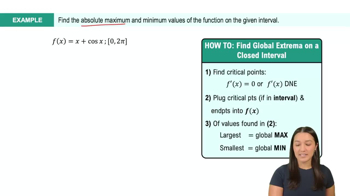Table of contents
- 0. Functions7h 52m
- Introduction to Functions16m
- Piecewise Functions10m
- Properties of Functions9m
- Common Functions1h 8m
- Transformations5m
- Combining Functions27m
- Exponent rules32m
- Exponential Functions28m
- Logarithmic Functions24m
- Properties of Logarithms34m
- Exponential & Logarithmic Equations35m
- Introduction to Trigonometric Functions38m
- Graphs of Trigonometric Functions44m
- Trigonometric Identities47m
- Inverse Trigonometric Functions48m
- 1. Limits and Continuity2h 2m
- 2. Intro to Derivatives1h 33m
- 3. Techniques of Differentiation3h 18m
- 4. Applications of Derivatives2h 38m
- 5. Graphical Applications of Derivatives6h 2m
- 6. Derivatives of Inverse, Exponential, & Logarithmic Functions2h 37m
- 7. Antiderivatives & Indefinite Integrals1h 26m
- 8. Definite Integrals4h 44m
- 9. Graphical Applications of Integrals2h 27m
- 10. Physics Applications of Integrals 2h 22m
5. Graphical Applications of Derivatives
Finding Global Extrema
Problem 4.R.16
Textbook Question
Find the critical points of the following functions on the given intervals. Identify the absolute maximum and absolute minimum values (if they exist).
g(x) = x sin⁻¹ x on [-1, 1]
 Verified step by step guidance
Verified step by step guidance1
First, understand that critical points occur where the derivative of the function is zero or undefined. We need to find the derivative of g(x) = x sin⁻¹ x.
To find the derivative, apply the product rule: if u(x) = x and v(x) = sin⁻¹ x, then g'(x) = u'(x)v(x) + u(x)v'(x).
Calculate u'(x) = 1 and v'(x) = 1/√(1-x²) using the derivative of sin⁻¹ x. Substitute these into the product rule formula to get g'(x) = sin⁻¹ x + x/√(1-x²).
Set g'(x) = 0 to find critical points: sin⁻¹ x + x/√(1-x²) = 0. Solve this equation for x within the interval [-1, 1].
Evaluate g(x) at the critical points and endpoints of the interval [-1, 1] to determine the absolute maximum and minimum values. Compare these values to identify the absolute extrema.
 Verified video answer for a similar problem:
Verified video answer for a similar problem:This video solution was recommended by our tutors as helpful for the problem above
Video duration:
4mPlay a video:
Was this helpful?
Key Concepts
Here are the essential concepts you must grasp in order to answer the question correctly.
Critical Points
Critical points of a function occur where its derivative is either zero or undefined. These points are essential for identifying local maxima and minima, as they represent potential locations where the function's behavior changes. To find critical points, one must first compute the derivative of the function and solve for the values of x that satisfy these conditions.
Recommended video:

Critical Points
Absolute Maximum and Minimum
The absolute maximum and minimum values of a function on a closed interval are the highest and lowest values the function attains within that interval, including at the endpoints. To determine these values, one must evaluate the function at its critical points and at the endpoints of the interval. The largest and smallest of these values will be the absolute maximum and minimum, respectively.
Recommended video:

Finding Extrema Graphically Example 4
Inverse Sine Function
The inverse sine function, denoted as sin⁻¹(x) or arcsin(x), is the function that returns the angle whose sine is x. It is defined for x in the range [-1, 1] and outputs angles in the range [-π/2, π/2]. Understanding the properties of the inverse sine function is crucial when analyzing the function g(x) = x sin⁻¹(x), as it affects the behavior and differentiability of g(x) within the specified interval.
Recommended video:

Inverse Sine
Related Videos
Related Practice









